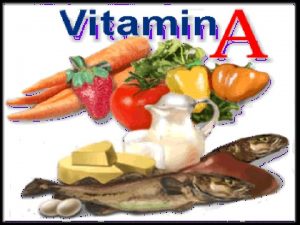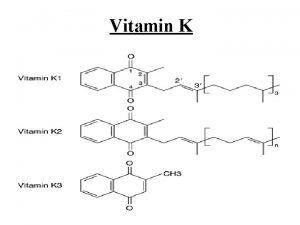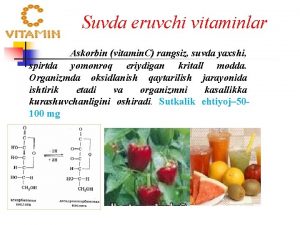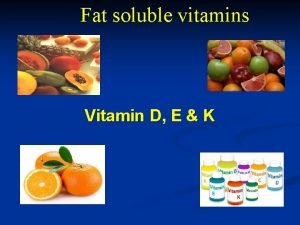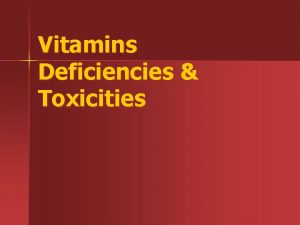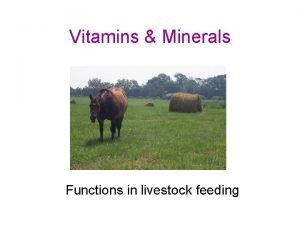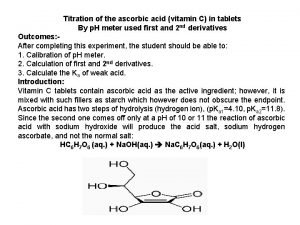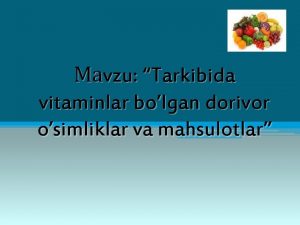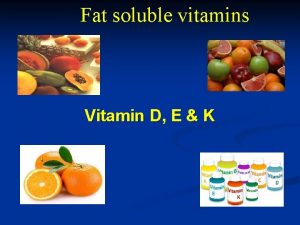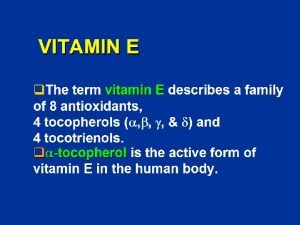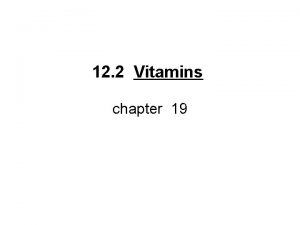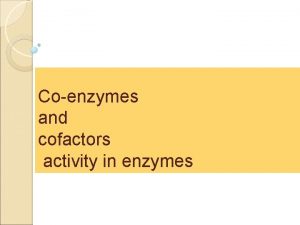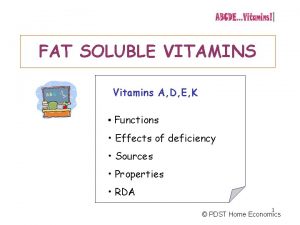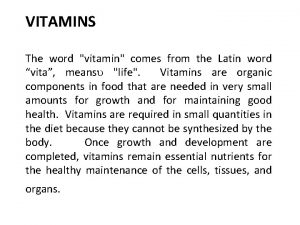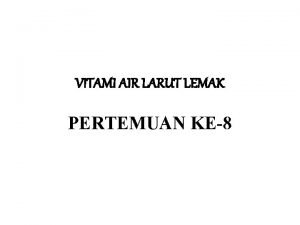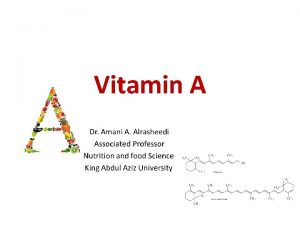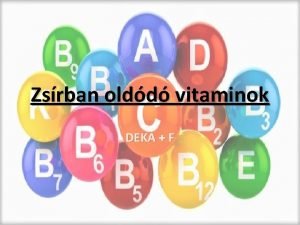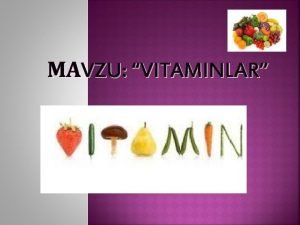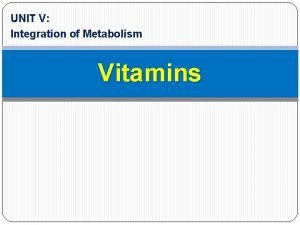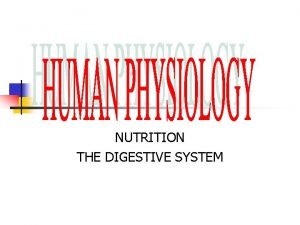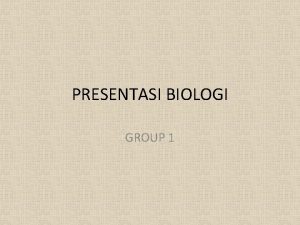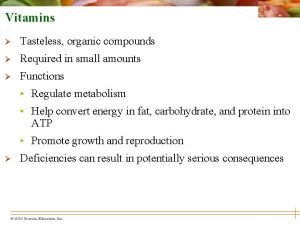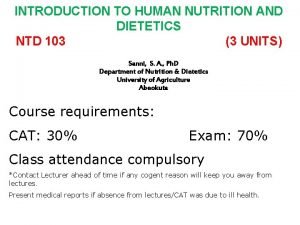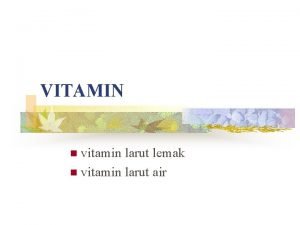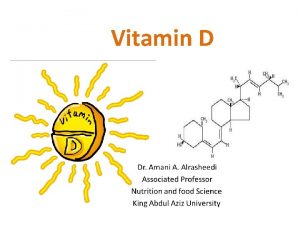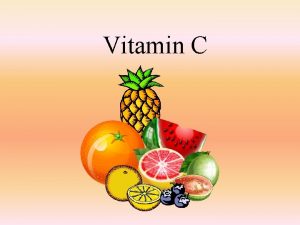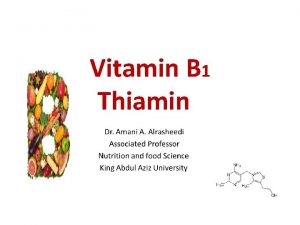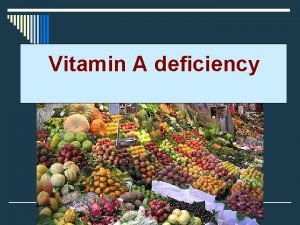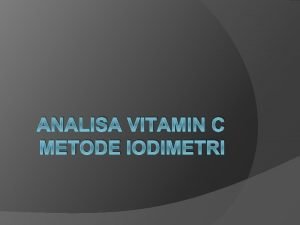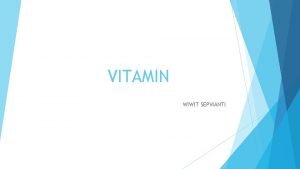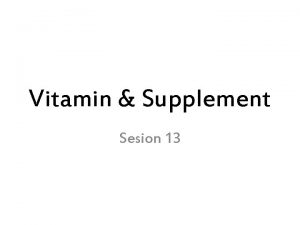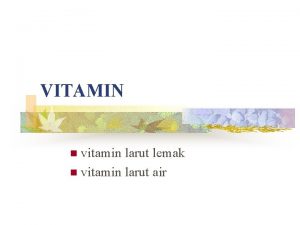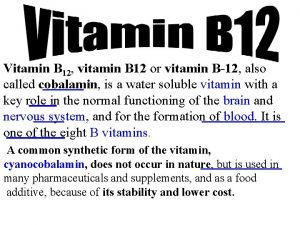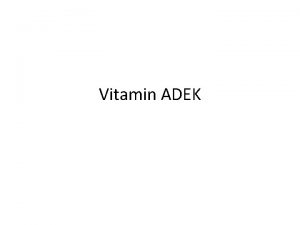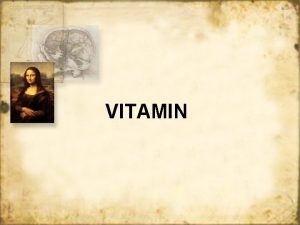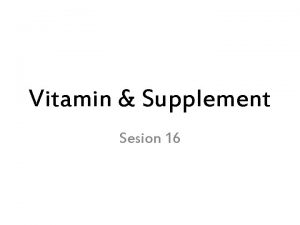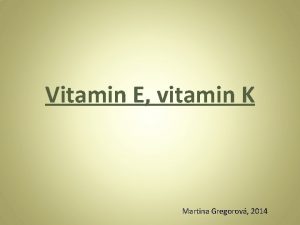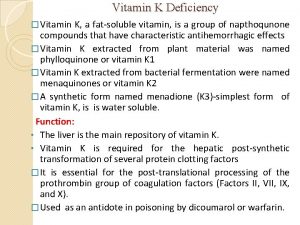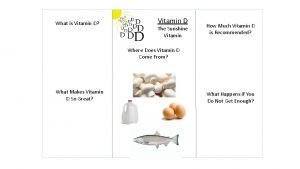Vitamin K Vitamin K Vitamin K is a




































- Slides: 36

Vitamin K

Vitamin K • Vitamin K is a fat-soluble vitamin which plays a vital role in the coagulation system. Two natural forms of vitamin K: • Vitamin K 1( phylloquinone): from vegetable and animal sources. • Vitamin K 2 ( menaquinone): which is synthesized by bacterial flora.

Sources and daily requirements • Sources of vitamin K : green leafy vegetables such as spinach, margarine, liver and vegetable oils like olive, canola, and soybean oils. • Daily requirement : 100 μg /d.

RDA is 100 μg /d.

Functions of vitamin K • Vitamin K in it’s active form (hydroquinone) is required for carboxylation of glutamic acid, which is necessary for calcium binding to some important coagulation proteins such as prothrombin (factor II) , factors VII, IX, and X , protein C and protein S.

Metabolism of vitamin K Hydroquinone Ca++ active coagulation proteins

Vitamin K deficiency Causes of vitamin K deficiency: 1. Malabsorption (celiac disease, Crohn's) 2. Obstructive biliary diseases. 3. Use of broad-spectrum antibiotic. 4. Prematurity. 5. Drugs ( warfarin , orlistat )

Clinical features of vitamin K deficiency • The main symptom of vitamin K deficiency is hemorrhage. ( bruises, hematemesis, melena hematuria, prolong bleeding after circumcision, epistaxis, intracranial hemorrhage) • Newborn infants (1– 7 days after birth) are particularly susceptible to vitamin K deficiency (hemorrhagic disease of the newborn).

Diagnosis of vitamin K deficiency • • Clinical features. Elevated prothrombin time ( PT ). Reduced level of clotting factors( II, X, IX, VII). Vitamin K level may also be measured directly by HPLC.

Treatment • Vitamin K 10 mg IM or IV. • For patients with sever bleeding FFP or blood transfusion may be required.

Prevention • Vitamin K (1 mg IM) is given prophylactically at birth for newborn babies. • Chronic malabsorption, 1– 2 mg/d of vitamin K should be given orally, or 1– 2 mg/week parenterally.

Vitamin E

Vitamin E • Vitamin E is a fat soluble vitamin which acts as an antioxidant.

Vitamin E Two isoforms: • Tocopherols. • Tocotrienols. • Only tocopherol meets human requirements.

Sources and daily requirement • Sources : sunflower oil, soybean, corn oils, meats, nuts, cereal grains, and small amounts are present in fruits and vegetables. • The daily requirement of vitamin E is 15 mg/d.

The daily requirement of vitamin E is 15 mg/d

Functions of vitamin E • Vitamin E protects low-density lipoproteins (LDLs) and polyunsaturated fats in cell membranes (nerve cells, RBCs ) from oxidation. • Increase sexual performance. • Improve immune function. • Prevent cardiovascular disease. • Slow aging process.

Vitamin E deficiency It is extremely rare seen only in : • Severe and prolonged malabsorptive diseases (celiac disease, cystic fibrosis). • Prolonged cholestasis. • Familial vitamin E deficiency due to defect in the tocopherol transport protein.

Clinical features of vitamin E deficiency • Peripheral neuropathy characterized by areflexia, ataxic gait, decreased vibration and position sensations. • Ophthalmoplegia. • Skeletal myopathy. • Retinopathy. • Hemolytic anemia. • Increased susceptibility for certain viral infections.

Diagnosis and treatment • Diagnosis : low blood level of tocopherol. • Treatment : 800– 1200 mg of tocopherol per day. • Higher doses may be required for patients with malabsorption.

Vitamin E Toxicity • High doses of vitamin E (>800 mg/d) may reduce platelet aggregation and interfere with vitamin K metabolism and are therefore contraindicated in patients taking warfarin.

Water soluble vitamins

Vitamin C

Vitamin C • Vitamin C is a water soluble vitamin which plays a vital role in connective tissue metabolism.

Vitamin C Tow biologically active forms: • Ascorbic acid. • Dehydroascorbic acid.

Sources and daily requirements • Sources of vitamin C include : Citrus fruits, green vegetables, tomatoes, and potatoes. • The daily requirement: 90 mg/d for males and 75 mg/d for females. • Smoking, hemodialysis, pregnancy, stress (infection, trauma) and drugs like steroids and NSAID appear to increase vitamin C requirements.


Functions of vitamin C • Connective tissue metabolism and crosslinking (proline hydroxylation). • Antioxidant activity (protect against cancer). • Promotion of nonheme iron absorption.

Functions of vitamin C • The conversion of dopamine to norepinephrine. • Synthesis of many peptide hormones. • Is a component of many enzyme systems. • In high doses decrease the severity of respiratory tract infection.

Vitamin C deficiency • Vitamin C deficiency causes Scurvy which is primarily reflect impaired formation of mature connective tissue. Causes of vitamin C deficiency: • Malnutrition (lack of fresh fruits and vegetables for > 2 months). • Elderly and infants. • Alcoholics.

Clinical features of Scurvy • Bleeding into skin (petechiae, ecchymoses, perifollicular hemorrhages). • Inflamed and bleeding gums. • Bleeding into joints, the peritoneal cavity, GIT pericardium, and the adrenal glands. • Poor wound healing. • In children, vitamin C deficiency may cause impaired bone growth.




Diagnosis and treatment of Scurvy Diagnosis : • Clinical features. • Low plasma or leukocyte level of vitamin C. Treatment : • vitamin C (250 mg 8 hourly) improves the symptoms of scurvy within a matter of several days. • Encourage vitamin C rich diet.

Vitamin C toxicity • Acute toxicity : >2 g in a single dose may result in abdominal pain, diarrhea, and nausea. • Chronic toxicity : Chronic high-doses may result in an increased prevalence of kidney stones. • Chronic high doses may promote iron overload in patients taking supplemental iron. • High doses may induce hemolysis in patients with G 6 PD deficiency.
 Vitamin d for body
Vitamin d for body Bitot's spot
Bitot's spot Vitamin k synthesis
Vitamin k synthesis Bozulbang
Bozulbang A d e k vitamin
A d e k vitamin Vitamin a indications
Vitamin a indications Biochemical function of vitamin a
Biochemical function of vitamin a Ascorbic acid titration curve
Ascorbic acid titration curve Gazanda o'simligi
Gazanda o'simligi Rda ai
Rda ai Roles of vitamin c
Roles of vitamin c Neil mooser reaction
Neil mooser reaction Vit larut dalam air
Vit larut dalam air Korrin halka sistemi
Korrin halka sistemi Vitamin a d e k are
Vitamin a d e k are Beri beri
Beri beri Thiamin
Thiamin Cigna not covering vitamin d testing
Cigna not covering vitamin d testing Vitamin untuk induk babi menyusui
Vitamin untuk induk babi menyusui Vitamin cofactors
Vitamin cofactors Water soluble vitamins adek
Water soluble vitamins adek The word vitamin comes from
The word vitamin comes from Vitamin larut dalam lemak
Vitamin larut dalam lemak Pantothenic acid rda
Pantothenic acid rda Vitamin a foods examples
Vitamin a foods examples Vitamin a roles
Vitamin a roles Essential vs nonessential nutrients
Essential vs nonessential nutrients Deka vitaminok
Deka vitaminok Vitamin e benefits
Vitamin e benefits Vitamin saqlovchi o'simliklar
Vitamin saqlovchi o'simliklar Vitamin d mushroom powder
Vitamin d mushroom powder Vitamin c deficiency symptoms
Vitamin c deficiency symptoms Deficiency of vitamin
Deficiency of vitamin Aseroftol
Aseroftol Where vitamins are absorbed
Where vitamins are absorbed Vitamin flowchart
Vitamin flowchart Uji vitamin b2 dengan alkohol
Uji vitamin b2 dengan alkohol

